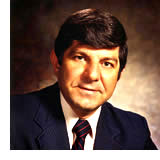Robert (Bob) Baboian
Robert Baboian is a corrosion consultant. He retired from Texas Instruments Incorporated on December 31, 1996 as a Principal Fellow and Head of the Electrochemical and Corrosion Laboratory in the Advanced Development Department of the Materials and Controls Group. He joined TI in September 1966 as a member of the Scientific Technical Staff of the Research & Development Department. He was elected a TI Fellow in 1976, a TI Senior Fellow in 1980, and a TI Principal Fellow in 1988.

After completion of his graduate work at RPI on electrochemistry of titanium, zirconium, and hafnium in molten salts, Robert Baboianwas awarded a Ford Foundation Post-doctoral Fellowship at the University of Toronto where he developed a high-temperature solution calorimeter for molten salts and liquid metals. He was subsequently appointed Senior Research Associate and continued the work in electrochemistry and thermodynamics of molten salts and oxides. Robert Baboian's initial work at Texas Instruments led to fused salt processes for the electrodeposition of titanium, removal of plastics from metals, recovery of scrap metals and production of gall resistant coatings.
After establishing the Corrosion Laboratory in 1968, he initiated work on design and evaluation of corrosion resistant materials and devices for corrosion control. He has (1) developed fundamental principles for galvanic corrosion, (2) has established electrochemical techniques for investigation of corrosion reactions and has developed devices for corrosion control, (3) has established test methods and design criteria for clad metal systems. He has gained international recognition for this work and has assisted in establishing a major business opportunity based on corrosion resistant materials and devices. Robert Baboianhas pioneered the use of electrochemical techniques for galvanic corrosion. His use of polarization, zero resistance ammeter and potential techniques in the study of galvanic effects has been published widely. He has lectured throughout the world on galvanic corrosion and was a consultant to the National Park Serviceon the restoration of the Statue of Liberty.
Robert Baboianhas provided key contributions in the application of a wide range of clad metals for corrosion control. These include stainless steel clad aluminum for trim and bumpers, clad transition materials for joining dissimilar metals, clad materials for batteries, steel clad copper concentric neutral wire, copper clad stainless steel cable shielding, various clad metals for heat exchangers, a wide range of clad coinage materials, and platinum clad niobium for anodes. Platinum clad niobium strip and wire has gained worldwide use for cathodic protection anodes. This is due to the key contributions Robert Baboianhas made in testing and design of these clad materials for this application. His publications on mechanisms of degradation and platinum consumption rates have been widely cited and are responsible for the introduction and wide use of these anodes for cathodic protection in North America.
He has made major contributions to the development of clad metals for U.S. Coinage. He has developed the environmental tests for coinage materials used by the U.S. Mint and performed these tests in the development of new clad coinage materials and the new U.S. penny and dollar coins.

Connect with us
Contact us today